- Joined
- Apr 20, 2022
- Messages
- 241
- Reaction score
- 211
I was wondering if folks could give me some insight,as I am new to the wood/ canvas canoe tripping, and would like to know…and see what you all pack for a weekend, week and longer…thanks!
Interesting… any traditional gear you take..like old canvas packs, pack basket…etc?You specifically mention w/c canoes, canoe material would not make any difference.
One week or six weeks the only difference is the amount of food.
I don't really do any weekend paddling, the time and effort just isn't worth the effort. When I do go on a weekender I usually let the others provide all the group gear and food so I just need the appropriate clothing, tent, sleeping bag/pad, personal items and a big bag of pot (I'm usually the guy that supplies the pie(s) for all).
I am always either paddling solo on my own or solo with a group of other solos, for a longer trip I bring enough gear to be entirely self sufficient if need be and I prefer to travel with those that do the same.
My packing list is in my head, to some it would be excessive, to others not so much.
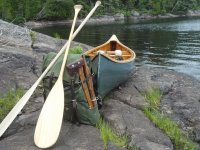
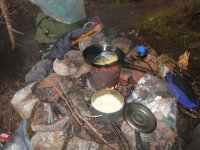
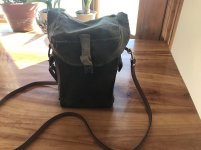
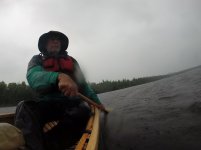
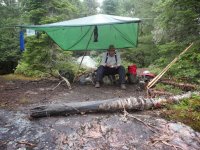
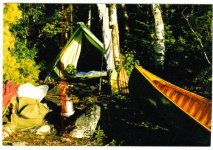
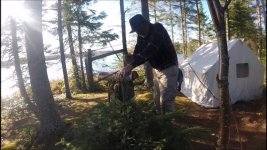
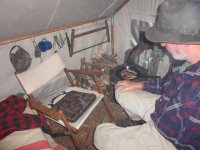
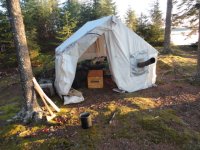
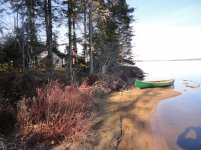


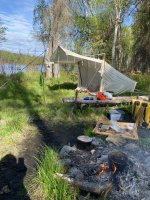

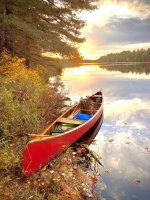
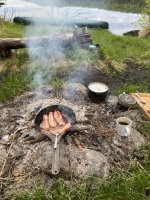
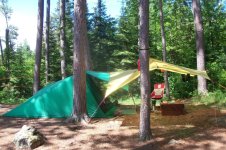

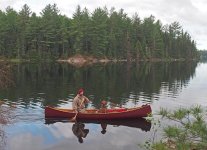
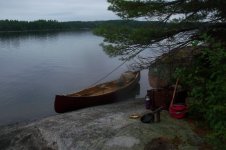
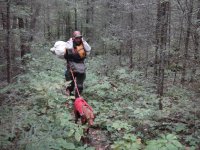

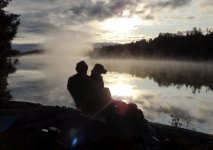
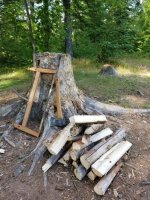

Wonderful…thank you! The list is very helpful! The pictures and the description and explanation… much appreciated..I have paddled and tripped with wood canvas canoes exclusively since the late 80's and here's a list of gear I would take on solo portage trips,
-Wood Canvas canoe, started with a 16' Chestnut Pal, went to a 15' Chestnut Chum or a 14' reproduction Chestnut Fox. My last portage trip was with the Chum.
-homemade portage pads using leftover canvas/tacks from canoe work
-2 ash beavertail paddles
-2 Duluth Packs, which vary from trip to trip, sometimes a Wanderer and Cruiser, sometimes a Day Pack for food and a #3 pack or any combination. (two small Sealine bags for food storage carried in the Duluth Pack)
View attachment 136645
-Snow and Nealley Hudson Bay Ax
-old Maine-made Schmidt Pack Saw
-old American-made Schrade folding knife
-an old stainless 1 liter pot with a latching lid, inside fits 2 Boy Scout alum plates, matches, lighter, scouring pad, extendable fire blowing tube, salt bottle, pot grabber.
-spatula
-cold handle frying pan
-littl bug twig stove
-blue metal coffee cup
-water bottle
-Grocery store food, instant potatoes, pasta, jerky, some fresh frozen meat stored in the bottom of a pack for the first fewdays, a couple of small zucchini from the garden, fresh caught fish, pancakes, bacon, granola bars, some rum.
View attachment 136647
-small military surplus bag with fish lures, small binocs, camera, needle nose plyers, some wire, and a small flattened roll of duct tape for repairs.
View attachment 136648
-small first aid kit and PFD, bandana, ball cap and bigger hat, rain gear, LL Bean Boots or Muck Boots, crocks, SPOT X satellite message device, compass, maps, ample clothes for warmth.View attachment 136649
Old Timberline 4 Tent with an old patched GREEN Campmore tarp, sleeping bag and mattress.
View attachment 136650
View attachment 136652
That's about it for when I used to do portage trips
Nowadays my preferred way to camp is with my wall tent, wood stove, old Byers cot, waningan, old restored wood/canvas chair, and a cooler with fresh meat out of my 16' Chestnut Cruiser. This is a non-portage trip but I have over 100 nights in the tent in paddle in campsites. I try to keep as traditional camp as possible, very comfortable.
View attachment 136654View attachment 136655View attachment 136656View attachment 136657View attachment 136658View attachment 136659
-
Thank you Glen! Yes I was inquiring about the older gear as I am attempting to put together my own set now that I have finished restoring my w/c canoe…but all information is helpful and much appreciated!CTC, I'm not clear about what you are asking. When you say "traditional" kit in your title and mention wood/canvas canoes in your OP, are you asking about what kind of old-fashioned/traditional gear to take to replicate gear from 100 years ago? If so, @Robin has just posted a wonderfully thorough photo essay.
However, if by "traditional" kit you simply mean one's "typical" tripping kit, then like @recped, my kit wouldn't change with the canoe hull construction material. Some trippers typically pack ultra-light, or semi-light, or take the kitchen sink. Like recped, the only thing that would change for me on a weekend vs. a longer trip would be the amount of food and maybe an extra pair of pants and shirt.
I'm not going to list everything I take, but my kitchen is just a JetBoil stove, an insulated drinking cup, a spork, and commercial freeze-dried meals along with snacks. I don't process much wood anymore, but I take a folding Silky saw and maybe a short machete. A light tent, air mattress and air pillow. A silnylon tarp I rarely put up. Gravity water filter. GPS with loaded topo and satellite maps. My only exception to lightweight gear in my old age is a full-size bag chair.
So that's the core of my typical kit, but it's not very 100-year-ago traditional, if that's what you mean. I do use Duluth packs, and and an Ursack (with Opsaks) for the food, but never barrels.
Thank you Lowangle Al… this is how I feel as well thank you for the detailed info and beautiful pics…I will post my boat a restored OT Yankee so if you see me in the. Adirondacks please say hi!I have two separate kits, one in Ak and the other in Pa. When I started putting a kit together in the early nineties I didn’t intend to go traditional but then I bought my first Duluth pack. After a short learning process I really liked how the Duluth pack worked, especially with the tumpline. I phased out my large roll to dry bag packs and replaced with canvas bags. In the last two years I have added pack baskets to my East coast kit and a wannigan to my Ak kit. I see benefits in all of these traditional pieces of gear that suit my tripping style compared to more modern stuff.
The traditional gear may be heavier, but for me it makes life easier and more comfortable.
Cotton campfire tent and wannigan.
View attachment 136666
Traditional packs in a modern Kevlar boat.
View attachment 136667
Fully loaded 18’ OT Guide at Lows Lake in the Adirondacks.

A hot tent with a wood stove really make things nice.

if I had a choice, I’d do all my trips in a wood canvas boat.
View attachment 136671
Can’t forget the cold handle frying pan.
View attachment 136672
For me traditional gear just works. The fact that it’s nice to look at and makes me feel good is a bonus.
Thank you Bob…love Jake…you two are definitely best buds…Coop will get his first ride in the restored canoe in about a week and a half…can’t wait to have him in it! Love the gear and explanations…huge help…especially explaining going slow…I did a short 3 day trip and watched everyone blow by meI seldom travel in my wood canvas much anymore - long story. But I still use the same gear. I take my lean one plus and large 8 x 14 tarp - do not really need a tarp that big - but I have it so I take it. I also always have my wool pull over long shirt and red toque for sleeping and for cold days. I use guide style paddles - oiled - beaver tail ( prefer sassafras as my joints appreciate the slight flex on long paddle days ). Cold handle fry pan, Solo Stove twig stove, copper boiler and titanium pot with lid. I use a large canvas bag as my main gear hauler and tump it. I usually take a small forest ax, but some times take a hatchet. I cut rounds with a buck saw. I used to travel with a wanigan, but the last couple years have not.
All my canoes - tandem - are rigged solo, and have a tump for portaging. Jake, myself and our gear come in around 400 pounds and that is just a little too big for most solos, so we paddle tandems with one seat rigged as a humongous solo. This is great because as Jake ages, he needs to move around more. His joints get sore sitting, laying in one position for too long. So I guess I forgot to mention I always take my canoe buddy Jake along with me as well. He has a harness, and a removable bag for carrying some of his food and some medicine, and because he is a Vizsla he must have a coat as he can get terrible cold even is summer. I do not take a sleeping bag. I take a blanket. Jake fits under it and we keep each other warm. Also, I can not stand sleeping bags.
I travel slowly, and often make changes to routes so traveling solo seems to be best for me.
View attachment 136675View attachment 136676View attachment 136677View attachment 136678View attachment 136680View attachment 136679View attachment 136681View attachment 136682View attachment 136683
Bob.
I too love a pack basket… I purchased the pack sak and it is really great … I think it is intended for ice fishing… but has several side pockets on the inside that I can organize my gear to a degree and a top that can be twisted closed… at least in an upset most of the gear would be together in theory… thank you for the response!We always take a traditional black ash pack basket. I realize the contents are not secure in an upset, but the convenience of an open top container is really nice, so we risk it.
Thank you Lowangle Al… this is how I feel as well thank you for the detailed info and beautiful pics…I will post my boat a restored OT Yankee so if you see me in the. Adirondacks please say hi!
cheers
CTC
Drew
How’s the Lean Plus in the rain and wind… looks awesome as a setupI seldom travel in my wood canvas much anymore - long story. But I still use the same gear. I take my lean one plus and large 8 x 14 tarp - do not really need a tarp that big - but I have it so I take it. I also always have my wool pull over long shirt and red toque for sleeping and for cold days. I use guide style paddles - oiled - beaver tail ( prefer sassafras as my joints appreciate the slight flex on long paddle days ). Cold handle fry pan, Solo Stove twig stove, copper boiler and titanium pot with lid. I use a large canvas bag as my main gear hauler and tump it. I usually take a small forest ax, but some times take a hatchet. I cut rounds with a buck saw. I used to travel with a wanigan, but the last couple years have not.
All my canoes - tandem - are rigged solo, and have a tump for portaging. Jake, myself and our gear come in around 400 pounds and that is just a little too big for most solos, so we paddle tandems with one seat rigged as a humongous solo. This is great because as Jake ages, he needs to move around more. His joints get sore sitting, laying in one position for too long. So I guess I forgot to mention I always take my canoe buddy Jake along with me as well. He has a harness, and a removable bag for carrying some of his food and some medicine, and because he is a Vizsla he must have a coat as he can get terrible cold even is summer. I do not take a sleeping bag. I take a blanket. Jake fits under it and we keep each other warm. Also, I can not stand sleeping bags.
I travel slowly, and often make changes to routes so traveling solo seems to be best for me.
View attachment 136675View attachment 136676View attachment 136677View attachment 136678View attachment 136680View attachment 136679View attachment 136681View attachment 136682View attachment 136683
Bob.
That looks excellent… those cinnamon buns … man o’ man! I see the cold handle skillet seems to be a theme in these kits…. Very nice indeedHere's my semi-traditional setup. Traditional: Wood/canvas canoe, wooden paddles, wooden wannigans, canvas duffels, leather tumplines, aluminum billy pots, reflector oven. Modern: Eureka Timberline tent, nylon tarp, drybags (inside duffels), modern synthetic clothing/outerwear.
View attachment 136722inView attachment 136721View attachment 136724View attachment 136723
I like the pipe insulation idea… very clever, cheap and effective. I am looking forward to trying out my Whelen this fall… I will use that tidbit if I bring a sod cloth. Your lean is a significantly lighter option. CCS makes great equipment for sure. I’m tempted to try sewing a mash up between the hid lean design and the Whelen.. I like the depth of the lean and the wings of the Whelen. I found a canvas company that sells 8.5 ounce sunforger and the sample they sent rivals the material in the snowtrekker tents . Thanks BobHey Drew,
The CCS Lean one is very solid in wind, once you get used to setting it up it is quite robust … Jake and I have been in some serious storms, never came down, never ripped up.
it has no floor, but does have sod cloth. I have a piece of sil nylon for a floor, that lays over the sod cloth … water can run under but gear and sleeping kit stays dry. I also rig foam pipe insulation on the edge of the tarp that faces the door.
once in a while during a real belly wash of a rain water can run in the tent … not much dirt as solid rock Is under the light layer of duff … the foam keeps The lip of the tarp up and any water intrusion goes under it … keeping everything dry.
Bob.
